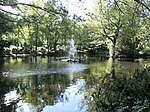Arboretum is a residential area of the City of Nottingham in the county of Nottinghamshire, England. The arboretum from which the neighbourhood takes its name was the first designated public park in Nottingham selected under the authority of the Inclosure Act 1845. The botanist and horticultural publisher, Samuel Curtis (1779–1860), oversaw the design of the park, on 11 May 1852, the park was officially opened. The park was opened by the Mayor of Nottingham, the lace manufacturer Mr W Felkin, and the Sheriff of the Borough of Nottingham, a Mr Ball, in front of a crowd of 30,000 people. It is Grade II* listed.
The park was designed as a botanical collection, in the "natural order", and as a tranquil place in which to relax, forming a major attraction in the heart of Victorian Nottingham. From 1852 it was open free of charge on Sunday, Monday and Wednesday, but was 6d admission (equivalent to £2.78 in 2020) on other days, or £1 (equivalent to £111.09 in 2020) for a yearly permit.
The Arboretum has become one of Nottingham's 'green lungs' and is a Green Flag-winning park. It is the city's oldest public park and also the closest park to the city centre. The park currently still contains more than 800 trees belonging to 65 species.Refreshment rooms built in the Tudor style were opened in 1852 to the designs of Henry Moses Wood by James Ebrank Hall, builder, with a banqueting hall occupying the entire frontage. The building also comprised a Ladies’ room, Refectory and Kitchen. An entrance hall and staircase led to three chambers upstairs. The whole building was constructed of brick with stone facings and was castellated along the front. The wings of the refreshment rooms were demolished in 1932. The remainder of the building traded as a hotel and restaurant and as a pub as The Arboretum Rooms, The Arboretum pub (also known as The pub in the Park), Arboretum Hotel and Arboretum Manor. In 1965 the building was severely damaged by fire and had to be almost completely rebuilt. In 2006, another fire resulted in its demolition.
The Circular Aviary was opened in 1889 with the original cast-iron uprights and roof struts covered with modern steel mesh. The Main Aviary of brick was constructed in 1955/6. The Upper Aviary was built in 1934 to house tropical birds.
The first bandstand was moved here from the green in Nottingham Castle in 1881 and placed in front of the Refreshment Rooms. The bandstand was replaced in 1907 with a new one designed by Frank Beckett Lewis the City Architect.There have been many functions held at The Arboretum including the annual Nottingham Pride festival.English Heritage has designated the site Grade II* status on the Register of Historic Parks & Gardens and the park's Bell Tower, bandstand and Circular Aviary have all received Grade II listing protection.'Arboretum' was also the name of a ward in the City of Nottingham until 2019, when it was merged with the Hyson Green ward to form the Hyson Green and Arboretum ward. At the time of the 2011 census, the former Arboretum ward had a population of 13,321.









